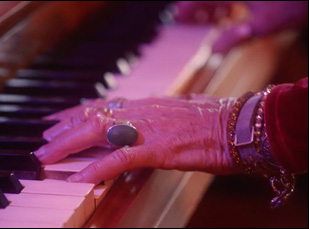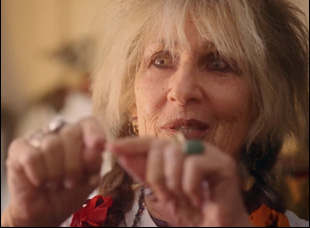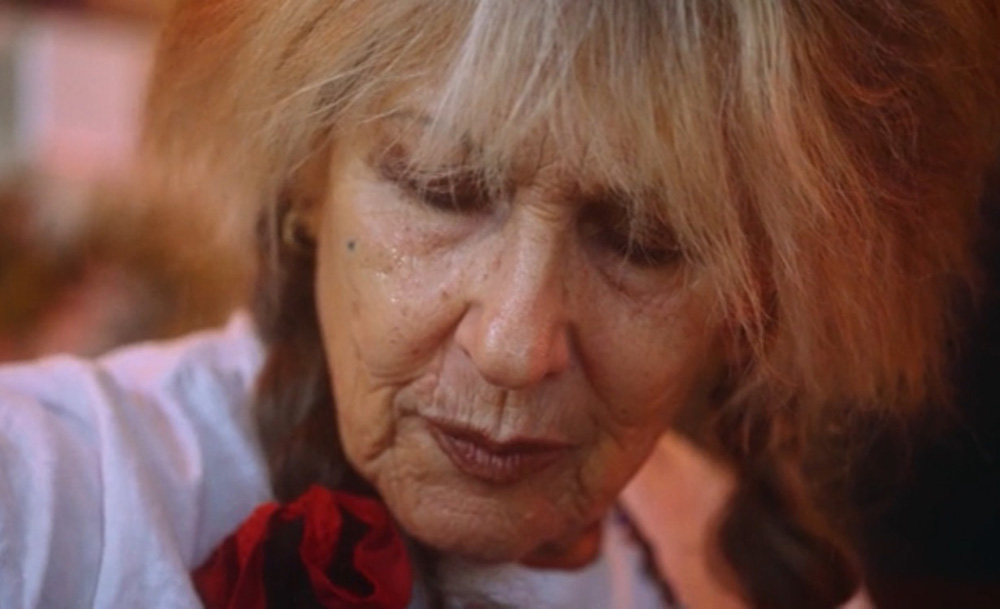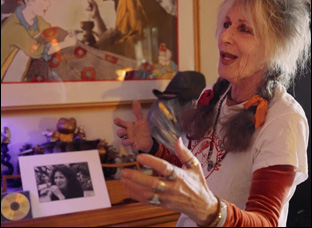“I’m not real big on a lot of major things, I’m more of a minor person,” says Madelynn von Ritz in the opening moments of “Madelynn Von Ritz is Almost Famous,” clarifying she’s speaking about the type of songs she’s known for writing as she plays a few notes on the piano. “Like a melancholy, that’s more my music.”
In fact, there may be a well of pain for von Ritz to draw on for her work as a singer/songwriter as one comes to learn in Naz Riahi and Silas Howard’s captivating short doc, but any sense of sorrow about where life has brought her is contradicted quite quickly by her joie de vivre, enthusiastically recalling professional and personal heartbreaks with chagrin and seeing it all as inspiration for new songs. At her humble home in Los Angeles, not far from where she once hung out with Cher and Jim Morrison on the Sunset Strip in the ‘60s, Von Ritz reflects on being always one step away from the spotlight, feeling all but abandoned by her mother who had her when she was just 17 and prematurely performing for the likes of Beatles producer George Martin for what could’ve been a big break, only it came too soon for her to have full command of the stage. She never stopped making music, but it was writing for other artists and even when it was for herself under the name of Lynn Castle, the records were unreleased.
Von Ritz’s voice has deepened with time and in between singing for Riahi and Howard, she offers stories that are just as rich, admitting she could “drop names until the cows came home” — and with gentle prodding from the directors, does spill a few — but for once, she’s given the opportunity to make a name for herself, presenting the music in her own words without the industry trappings that have long stood in the way. Shortly before the film’s premiere at Outfest in Los Angeles where it will accompany a retrospective screening of Howard’s groundbreaking debut feature “By Hook or By Crook,” co-directed with Harry Dodge, Riahi spoke of how she came to collaborate with Howard on the charming portrait of Von Ritz, allowing their subject a chance to shine as brightly as they knew she could and capturing her infectious energy with their camera.
I made a short called “Sincerely, Erik” at the height of the pandemic and we shot it in two days with just me and a [cinematographer] on set. On day one, we had this scene where my friend Monica came in to play this person who visits the store and in between setting up the shots, we were just playing for the store’s playlist and we were listening to a song about New York. The moment was very New York — it was in the middle of the pandemic and everything had been boarded up and we didn’t know what the future was and Monica said, “Oh my God, I just heard this other song about New York. You have to listen to it.” So she played this other song by Lynn Castle, this artist none of us had heard about, and I fell in love with the song.
I went home and listened to the whole EP and decided to use another one of her songs, “She Thinks, She Feels,” in my short film for that pivotal moment at the end of it. That’s how I came to know Lynn Castle a.k.a. Madelynn Von Ritz and when I was putting the song in my film, I decided to reach out to her. We connected and became friends and from the very first phone call we had, I thought, I would really love to make a documentary about this woman. I didn’t know when or how it would happen, but over a year later, Silas and I were flying to L.A. from New York and he said, “We should make a film together this week.” We called Madelynn and she said, “Absolutely, come on over.” And we did.
And this was your first doc, right? Was it different to set up?
Yeah, it was. I write all of my own work and with a narrative short, you go in knowing exactly what the film is going to be or as close as possible. Of course, things change on the day of and in the edit, they can change, but with a documentary, at least in this case, we had a sense of this really interesting person who had lived a life beyond our wildest imagination, so we didn’t exactly know what the story was going to be until we went and talked to her and looked at the footage that we had. Editing a documentary is so much more challenging. I studied journalism as an undergrad and I feel a responsibility to the truth and film is a media of manipulation and it was a place of growth because I felt like how do I stay completely honest and truthful and report this as it was, but still make it a cohesive story. That was a really exciting and interesting challenge and of course, it can be done.

Her space is so magical. Madelynn is very much a person who melds reality and fantasy in a beautiful and inspiring way and her home is a complete manifestation of that. It is full of things, but every single thing in that house is placed where it is with intention. It’s not random, and I was really blown away by that. You would go into the bathroom and there’s a light underneath the sink, coming out for example. I’d never seen anything like that. And there’s one section of the film where we use some B-roll to show her space a little bit and to show her things, but for Silas and I, it was really important to center Madelynn in the frame and to have her tell her story because she is someone, like many women, who hasn’t been given the opportunity to fill the frame of her own life and tell her own story, so we didn’t want to pull away from her. We didn’t want to show different things in the house, as captivating as they were, so that’s why we shot through things some times but always keeping her in the frame.
Is that part of what made the decision to shoot this in handheld?
Handheld offers a certain intimacy that sticks don’t. We had sticks there, but we decided not to use them and akin to my other films, there’s a certain rawness and lo-fi-ness that I employ because it allows a character and the story to shine if you don’t have all the bells and whistles. If you’ve seen my other work, this is the first film that was even colored in the way that it was. I very much like a muted palette, but with “Madelynn,” we had an amazing colorist where we said we still want to stay true and authentic to what we experienced and just enhance it a tiny bit, and that is still the most minimal that we went with the choices that we had.
But [generally] one of the things that’s really frustrating about the film industry is that things take forever to happen. You need funding, you need producers, you need to align schedules and I just want to make things and Silas is like that too, so [when] the two of us said, “Let’s make a film this week,” we didn’t think about the fact that would have a lot of limitations. We just thought, “What can we do? How can we make this happen?” We called Daniel McCoy, a friend of ours who’s an amazing sound recordist with a couple of cameras, and he said, “I’ll be there,” and the three of us took turns holding the cameras and just doing it. We didn’t go through a process of choosing lenses, choosing cameras, any of that. All of it is naturally lit. My [cinematographer] on the first two shorts used to tease me and say I was a very Dogme 95 director because I really try to employ what exists. [laughs] The house in “Andros in the City” is a house as it exists. The same with Erik’s apartment in “Sincerely Erik.”

Yeah, and the tapestry of her experiences and her wisdom is so profound that absolutely she could be a feature-length documentary. And it could be in the same style even of not employing talking heads and not using archival footage, which was really, really important for me and Silas because we wanted Madelynn to tell her story and not have to prove her experience, which is something that’s often asked of marginalized people. [The common mode is] Show me this happened. Of course, the archival footage exists out there, but I think that if it ever were to be a feature, I would love to do it in the same way of spending time with this person, but seeing a little bit more of her life, both the things that might seem mundane, but also the experience of her playing a show or recording some music.
Is there anything that happens that changes your ideas of what this could be?
Yeah, the first cut of this doc was 55 minutes because she has so many interesting stories and initially I thought about her life as a fairy tale. It has the same arc — the ups and downs — and of course her house is filled with fairy tale figurines, the Big Bad Wolf is everywhere. So when I first spoke to her, I immediately thought every chapter of her life is a fairy tale and I think there is a world in which that could work, but for a short doc, we didn’t have enough space to fully explore that, so we tried it, and it didn’t end up working quite as well. Alec [Cohen], who was one of the editors and also the [cinematographer] on the two shorts [I made previously] and my friend Noel [Paul], who has been my editor for “Andros in the City,” and the three music videos I did for Ella Hunt, were editors on this at different times and then Silas is just extraordinary in the edit. His brain just blows me away, the way he’s able to take something and know exactly the way in which the pieces need to be moved to make it work.
This makes me appreciate all the more that you kept the unbroken take of Madelynn listening to her song “Imagine You and Me” in there. How did that make the final cut?
We knew when she put that song on and she started listening to it, I was moved to tears. There was no question that had to go into the film. It moved around a little bit in the location of it and there was a certain point where she tells the first half of that story and then there’s a big cut and we go to another section and then we come back to it, but it needed to be all together in one piece. It does feel a little bit long, but that’s important to stay with her through that emotion. It felt like such a privilege to be able to share that with an audience, but also for her to have shared it with us because you can tell that people sometimes have once in a lifetime loves and it’s clear that cop was that to her. It’s heartbreaking that he died so shortly after they were married and had a baby, and that song is so incredibly beautiful and I don’t believe it’s been released. It hasn’t been on any of her EPs.

It’s so exciting. I’m so honored to have a film at Outfest and my hope is to get it out there so people can see it, but I also want to do right by Madelynn and so I’m being a little more patient with this one than I was with my narrative shorts [which premiered online]. I didn’t even submit my shorts to festivals. I was like, “It’s done. Here it is. Let’s show it to everybody,” and I have to temper my own impatience in order to serve Madelynn because if I can get it out with a partner that allows it to be seen widely, that would be my dream. She is a person that deserves everything good in the world and she has had, as she says, a “raggedy past” and a lot of ups and downs.
I found a quote by her the other day where she said something [like], “When I was a young woman I had this vision that when I was very old, young people would find my music and they would come to me and say that it moved them.” That’s powerful and what if this film is part of something that allows for that? I don’t have the hubris to say this film does that, but maybe it’s a piece of a bigger thing that does. That would be incredible.
“Madelynn Von Ritz is Almost Famous” will screen at Outfest LA on July 23rd at 8:45 pm before “By Hook or By Crook.”





